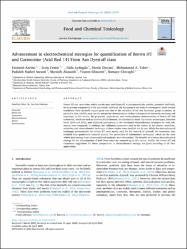| dc.contributor.author | Karimi, Fatemeh | |
| dc.contributor.author | Demir, Ersin | |
| dc.contributor.author | Aydoğdu, Nida | |
| dc.contributor.author | Shojaei, Moein | |
| dc.contributor.author | Taher, Mohammad A. | |
| dc.contributor.author | Asrami, Padideh Naderi | |
| dc.contributor.author | Alizadeh, Marzieh | |
| dc.contributor.author | Ghasemi, Younes | |
| dc.contributor.author | Cheraghi, Somaye | |
| dc.date.accessioned | 2022-06-09T11:43:07Z | |
| dc.date.available | 2022-06-09T11:43:07Z | |
| dc.date.issued | 2022 | en_US |
| dc.identifier.citation | Karimi, F., Demir, E., Aydogdu, N., Shojaei, M., Taher, M. A., Asrami, P. N., ... & Cheraghi, S. (2022). Advancement in electrochemical strategies for quantification of Brown HT and Carmoisine (Acid Red 14) Drom Azo Dyestuff class. Food and Chemical Toxicology, 113075. | en_US |
| dc.identifier.issn | 0278-6915 | |
| dc.identifier.uri | https://doi.org/10.1016/j.fct.2022.113075 | |
| dc.identifier.uri | https://hdl.handle.net/20.500.12933/1144 | |
| dc.description.abstract | Brown HT and carmoisine, which are the most used dyestuffs in pharmaceuticals, textiles, cosmetics and foods, are important components of the Azo family. Although the Azo group is not toxic or carcinogenic under normal conditions, these dyestuffs require great care due to the reduction of the Azo functional group to amines. In particular, fast, reliable, easy, on-site and precise determinations of these substances are extremely necessary and important. In this review, the properties, applications, and electrochemical determinations of brown HT and carmoisine, which are used as synthetic food colorants, are discussed in detail. Up to now, sensor types, detection limits (LOD and LOQ), and analytical applications in the developed electrochemical strategies for both substances were compared. In addition, the validation parameters such as the variety of the sensors, sensitivity, selectivity and electrochemical technique in these studies were clarified one by one. While the electrochemical techniques recommended for brown HT were mostly used for the removal of dyestuff, for carmoisine they included fully quantitative centered studies. The percentiles of voltammetric techniques, which are the most widely used among these electroanalytical methods, were determined. The benefits of a robust electrochemical strategy for the determination of both food colors are summed up in this review. Finally, the brown HT and carmoisine suggestions for future perspectives in electrochemical strategy are given according to all their applications. | en_US |
| dc.language.iso | eng | en_US |
| dc.publisher | Elsevier | en_US |
| dc.relation.isversionof | 10.1016/j.fct.2022.113075 | en_US |
| dc.rights | info:eu-repo/semantics/embargoedAccess | en_US |
| dc.subject | Brown HT | en_US |
| dc.subject | Carmoisine | en_US |
| dc.subject | Electrochemistry | en_US |
| dc.subject | Sensor | en_US |
| dc.subject | Determination | en_US |
| dc.title | Advancement in electrochemical strategies for quantification of Brown HT and Carmoisine (Acid Red 14) From Azo Dyestuff class | en_US |
| dc.type | article | en_US |
| dc.authorid | 0000-0001-9180-0609 | en_US |
| dc.authorid | 0000-0002-6194-5169 | en_US |
| dc.department | AFSÜ, Eczacılık Fakültesi, Temel Eczacılık Bilimleri Bölümü | en_US |
| dc.contributor.institutionauthor | Demir, Ersin | |
| dc.contributor.institutionauthor | Aydoğdu, Nida | |
| dc.identifier.volume | 165 | en_US |
| dc.identifier.startpage | 1 | en_US |
| dc.identifier.endpage | 10 | en_US |
| dc.relation.journal | Food and Chemical Toxicology | en_US |
| dc.relation.publicationcategory | Makale - Uluslararası Hakemli Dergi - Kurum Öğretim Elemanı | en_US |
















